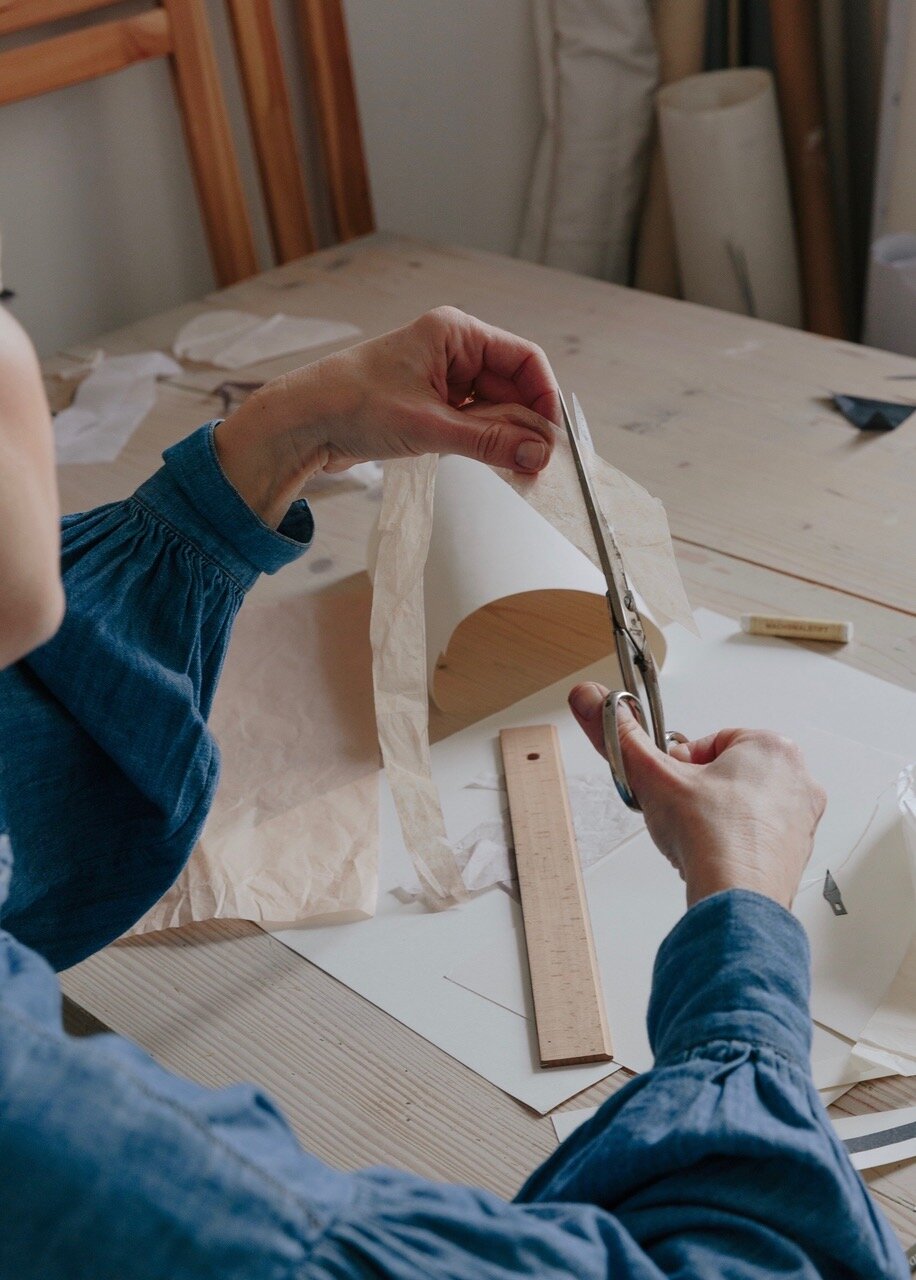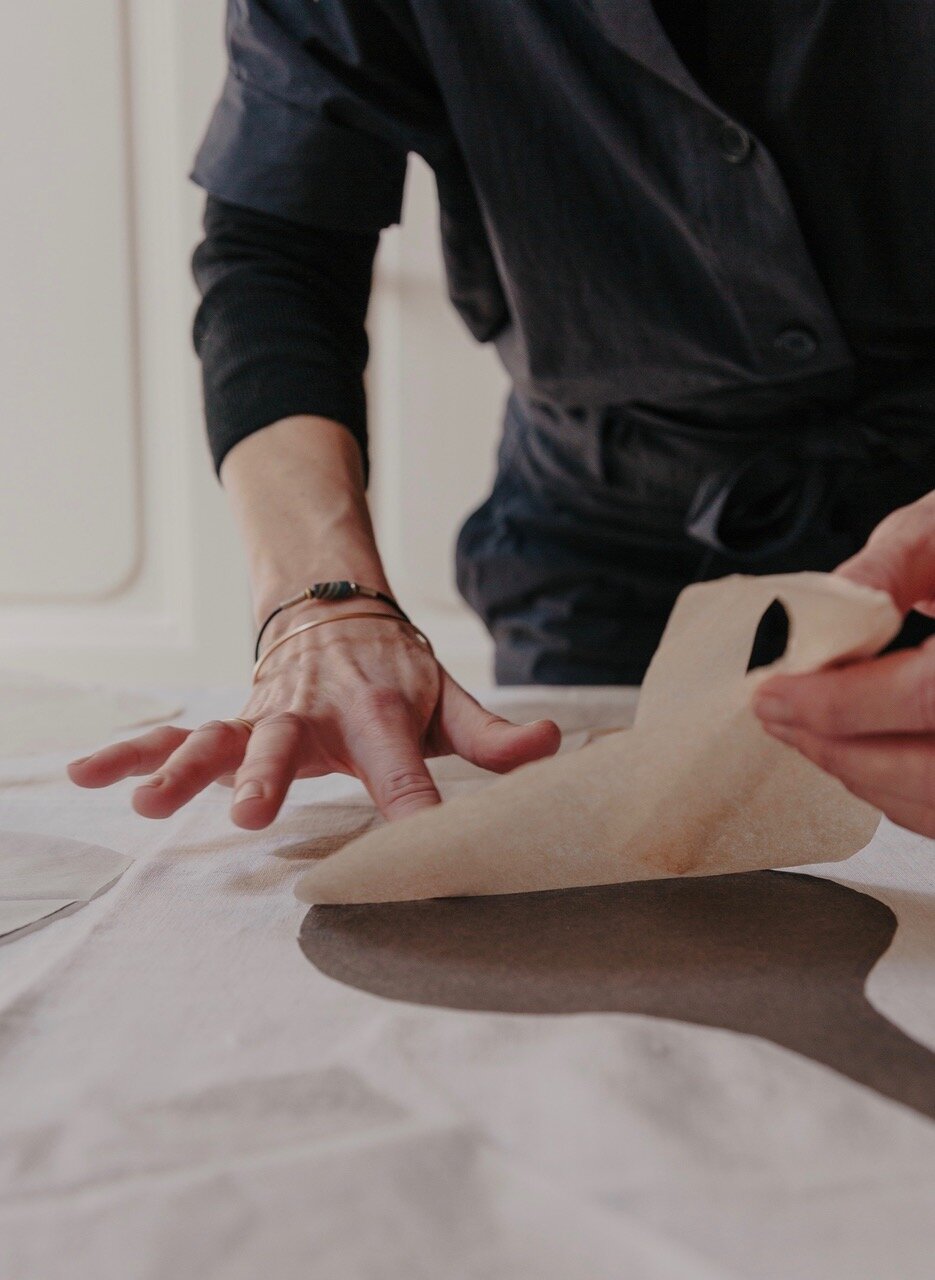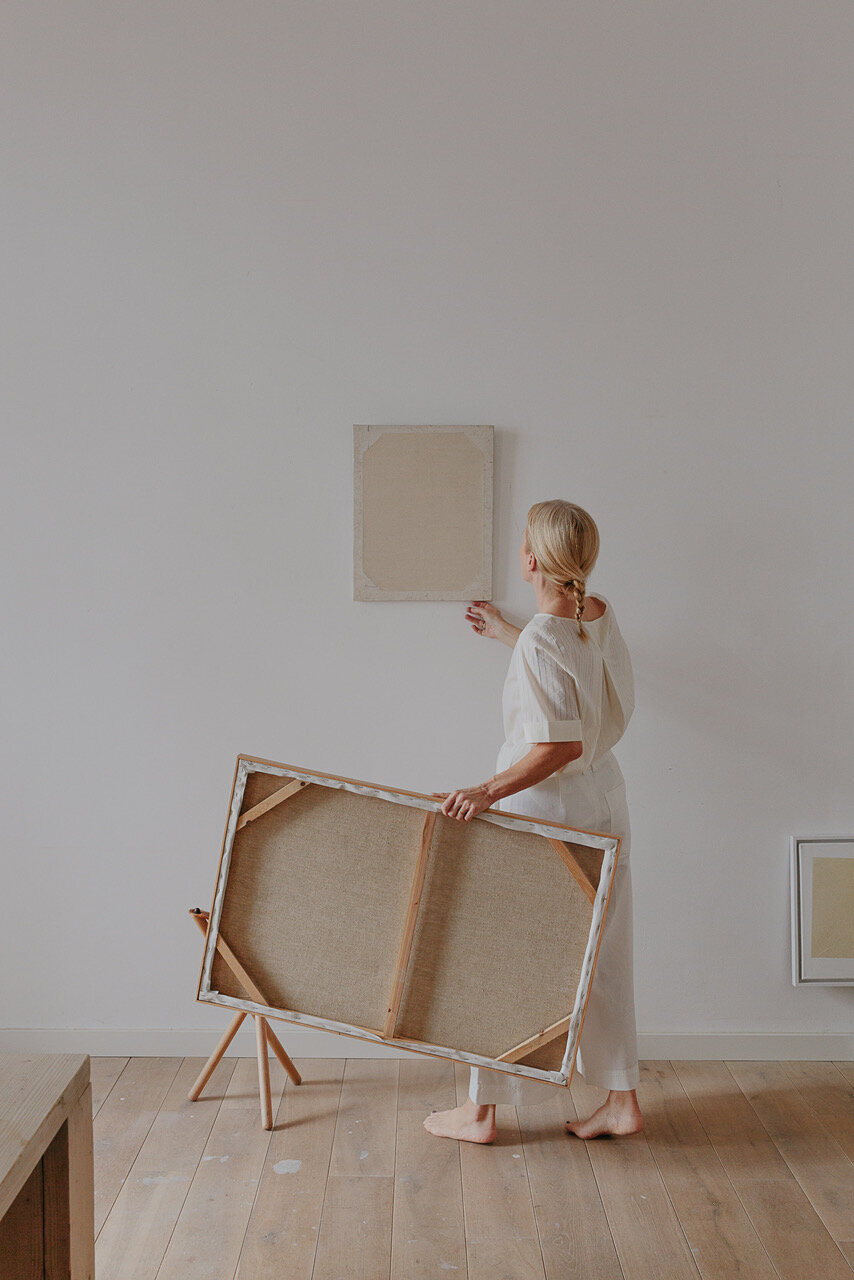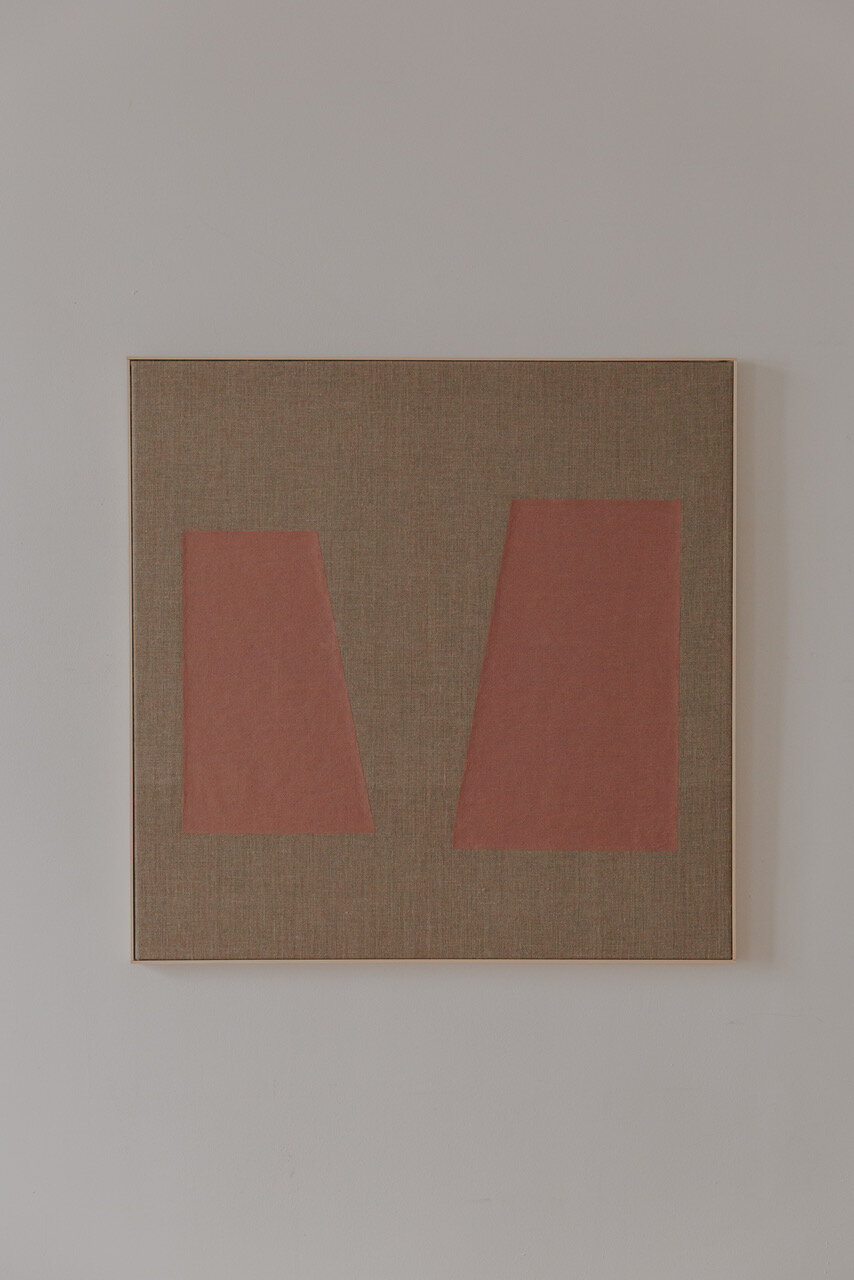REFLECT & REMEMBERKIM BARTELT
In her work, Kim Bartelt does not paint surfaces; she paints with surfaces. Instead of a brush with paint on it, her painterly work consists of irregular segments of colored and transparent sheets of paper which she applies to the canvas. Her technique and choice of materials could have been regarded as a reflection on the nature of painting. Her decision to abandon liquid paints in favor of two-dimensional, flat elements, could have been interpreted as a sort of investigation into the given characteristics of painting as a two-dimensional, flat object. But in fact, her work goes further than that.
Interview by:
New Norm Magazine
Photography by:
Marina Denisova
Country:
Berlin, Germany
Social:
I am an artist working with papers. Instead of a brush with paint on it, my painterly work consists of irregular segments of coloured and transparent sheets of paper which I apply to the canvas with glue. It is a meditative process that takes a long time to complete. The sensitivity of the papers which sometimes receive wrinkles upon application evokes the fragility of life and us humans in particular.
Reflect
Embracing slower living
1. Where are you from / call home?
Kim: I am born in Berlin, Germany. I spent many years in Paris and in New York but am back living in my hometown now.
2. What are some simple pleasures that you’ve rediscovered during the coronavirus pandemic?
K: It suddenly seems so precious to simply walk through a park, or to have an exceptional meeting with a friend, even with the distance. It all has gotten a whole new quality.
Luckily I‘ve been able to go to my studio just like before. With much more quiet and fewer distractions of course. But when it all started, and we were told to stay home, not to meet friends, I thought: Wow, so much time to do all those things I didn’t have time to do before. Finally, I would finish all the books and magazines which are lying around, and get back to work on some ceramics. But no, I didn’t manage to do any of this, I just continued working on new pieces.
Reflect
Embracing slower living
3. How have you and your creative process changed?
K: I have actually taken some time to look into other techniques to achieve the same effect as with my collaged papers. Something which has interested me a lot since my art history studies are fresco paintings, and egg tempera painting.
The luminosity and transparency of the papers are very important for me, and by overlaying many papers some of my works appear chalky and like fresco paintings. So, I thought that maybe I could do this with egg tempera as well. I was curious to take a brush in the hand again and to feel the sensuality of moving the brush in the paint and on the canvas. It is true, the tempera has a luminosity to it which is barely achieved with other paint. I haven’t figured it all out yet, and it doesn’t mean that I will switch to painting again, but another advantage of the egg tempera is the naturalness of this paint. One egg, the same amount of linseed oil, and a bit of pigment. Whereas I used all these glue sticks before, I can now mix my own paint from natural ingredients I have at home.
Isn’t this time of retreat and reflection also one of a ‘back to the roots’?
4. What are some of the things that have changed in your country as a result of the pandemic? What is the new normal?
K: Luckily Berlin was spared from a severe house arrest. We were advised to not leave the house if not necessary, but it was allowed all the time to do sports outside and to go for walks with members of the same household or one person from another household with 1.5 m distance. Since last week the stores are slowly opening again, galleries and museums have just followed. We do have to wear masks on public transportation and all stores from now on. How the new normal will develop we have yet to see over the course of the year.
Reflect
Travel from home
5. What was your favourite destination and why?
K: I did many beautiful travels, but here I must quote my recent trip to Japan last October.
I have been to Asia before but not to Japan which was obviously very inspiring for me as an artist. One is just taken away by all of the beauty and tradition. This trip was very spontaneous and not planned at all, I didn’t even have time to do research before, I had just asked some friends and fellow artists for tips and places I should visit. Something happened to me which has never happened before, I felt like all this was just a little teaser. I had the feeling that I hadn’t seen anything, although I did see so many beautiful things. It was as if I had only touched the edge of something and that it would need years to understand and transcend the Japanese culture, and see everything I wanted to see there. 10 days were not enough, I definitely need to go back.
Another very inspiring travel was one to Hong Kong at the end of the 80s. I was a child and went with my parents, and I remember how we were shocked to see people with cell phones walking around. The phones were almost as long as my lower arm, plus an antenna, and we were amazed by how people who could just walk around and talk with someone while walking on the street!
6. What are some of your most memorable moments during the trip?
K: The visit to the Moss Gardens in Kyoto, such a magical place. The garden was incredible, but what I loved about this experience so much is that not everyone can just visit this garden. You have to write a hand-written letter to the temple at least 3 weeks in advance as a foreigner, and receive a written answer with your name on it in return to be able to visit. As my trip was quite spontaneous and I had only 10 days left until the visit to Kyoto I asked my friend who was living in Kyoto at the time to write a letter (when based in Japan one week in advance for the letter is enough), she did receive an answer with both our names and a date and time we were invited to enter the garden.
But that wasn’t all: we couldn’t just go to the garden and look at it, no, we had to sit down in the temple first and copy a whole page of sutras until the end. They ask this so that you enter a state of concentration and meditation to prepare for the visit to the garden.
It was unbelievably beautiful, and I really think it would be wonderful to reach a similar attitude for traveling in the future. That people would have to express their intent to visit a special or holy place and prepare for it, not just go, take a photo or film it with an iPad, and move to the next thing. But to make it an experience.
7. What does travel give you that everyday life doesn’t?
K: It broadens your horizon, it lets you come back with a new look on things. It takes you out of the routine and throws you into a new scenery and culture. You take in new things and therefore lets you reevaluate the things left behind. A very important process to advance and learn.
8. You have an unlimited travel budget for 24 hours, where would you go?
K: That one is difficult. 24 hours is not long, so I wouldn’t travel too far to not lose any time. As I have never been to Antwerp before I would choose this city. To visit the Vervoordt sites like the Vlaeykensgang and especially the Kanaal buildings and galleries, and all the other wonderful places this city has to offer. I have been wanting to go for a long time and I think it will be one of my first trips after the confinement.









